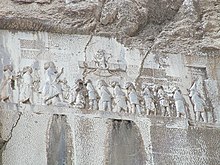Behistun
| Bisotun | |
|---|---|
| Name as inscribed on the World Heritage List | |

Modern-day picture of the inscription
|
|
| Location | Iran (Islamic Republic of) |
| Type | Cultural |
| Criteria | ii, iii |
| Reference | 1222 |
| UNESCO region | Asia-Pacific (Iran) |
| Coordinates | 34°23′26″N 47°26′9″E / 34.39056°N 47.43583°ECoordinates: 34°23′26″N 47°26′9″E / 34.39056°N 47.43583°E |
| Inscription history | |
| Inscription | 2006 (30th Session) |
The Behistun Inscription (also Bisotun, Bistun or Bisutun; Persian: بیستون, Old Persian: Bagastana, meaning "the place of god") is a multilingual inscription and large rock relief on a cliff at Mount Behistun in the Kermanshah Province of Iran, near the city of Kermanshah in western Iran. It was crucial to the decipherment of cuneiform script.
Authored by Darius the Great sometime between his coronation as king of the Persian Empire in the summer of 522 BC and his death in autumn of 486 BC, the inscription begins with a brief autobiography of Darius, including his ancestry and lineage. Later in the inscription, Darius provides a lengthy sequence of events following the deaths of Cyrus the Great and Cambyses II in which he fought nineteen battles in a period of one year (ending in December 521 BC) to put down multiple rebellions throughout the Persian Empire. The inscription states in detail that the rebellions, which had resulted from the deaths of Cyrus the Great and his son Cambyses II, were orchestrated by several impostors and their co-conspirators in various cities throughout the empire, each of whom falsely proclaimed kinghood during the upheaval following Cyrus's death.
Darius the Great proclaimed himself victorious in all battles during the period of upheaval, attributing his success to the "grace of Ahura Mazda".
The inscription includes three versions of the same text, written in three different cuneiform script languages: Old Persian, Elamite, and Babylonian (a variety of Akkadian). The inscription is to cuneiform what the Rosetta Stone is to Egyptian hieroglyphs: the document most crucial in the decipherment of a previously lost script.
...
Wikipedia

